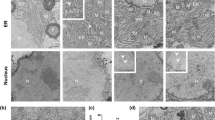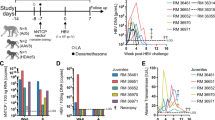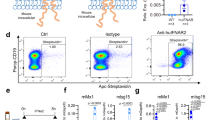Abstract
Hepatitis C virus (HCV) remains a major medical problem. Antiviral treatment is only partially effective and a vaccine does not exist. Development of more effective therapies has been hampered by the lack of a suitable small animal model. Although xenotransplantation of immunodeficient mice with human hepatocytes has shown promise, these models are subject to important challenges. Building on the previous observation that CD81 and occludin comprise the minimal human factors required to render mouse cells permissive to HCV entry in vitro4, we attempted murine humanization via a genetic approach. Here we show that expression of two human genes is sufficient to allow HCV infection of fully immunocompetent inbred mice. We establish a precedent for applying mouse genetics to dissect viral entry and validate the role of scavenger receptor type B class I for HCV uptake. We demonstrate that HCV can be blocked by passive immunization, as well as showing that a recombinant vaccinia virus vector induces humoral immunity and confers partial protection against heterologous challenge. This system recapitulates a portion of the HCV life cycle in an immunocompetent rodent for the first time, opening opportunities for studying viral pathogenesis and immunity and comprising an effective platform for testing HCV entry inhibitors in vivo.
This is a preview of subscription content, access via your institution
Access options
Subscribe to this journal
Receive 51 print issues and online access
$199.00 per year
only $3.90 per issue
Buy this article
- Purchase on Springer Link
- Instant access to full article PDF
Prices may be subject to local taxes which are calculated during checkout



Similar content being viewed by others
References
Pileri, P. et al. Binding of hepatitis C virus to CD81. Science 282, 938–941 (1998)
Scarselli, E. et al. The human scavenger receptor class B type I is a novel candidate receptor for the hepatitis C virus. EMBO J. 21, 5017–5025 (2002)
Evans, M. J. et al. Claudin-1 is a hepatitis C virus co-receptor required for a late step in entry. Nature 446, 801–805 (2007)
Ploss, A. et al. Human occludin is a hepatitis C virus entry factor required for infection of mouse cells. Nature 457, 882–886 (2009)
Zhu, Q., Guo, J. T. & Seeger, C. Replication of hepatitis C virus subgenomes in nonhepatic epithelial and mouse hepatoma cells. J. Virol. 77, 9204–9210 (2003)
Uprichard, S. L., Chung, J., Chisari, F. V. & Wakita, T. Replication of a hepatitis C virus replicon clone in mouse cells. Virol. J. 3, 89 (2006)
Chang, K. S. et al. Replication of hepatitis C virus (HCV) RNA in mouse embryonic fibroblasts: protein kinase R (PKR)-dependent and PKR-independent mechanisms for controlling HCV RNA replication and mediating interferon activities. J. Virol. 80, 7364–7374 (2006)
Lin, L. T. et al. Replication of subgenomic hepatitis C virus replicons in mouse fibroblasts is facilitated by deletion of interferon regulatory factor 3 and expression of liver-specific microRNA 122. J. Virol. 84, 9170–9180 (2010)
McCaffrey, A. P. et al. Determinants of hepatitis C translational initiation in vitro, in cultured cells and mice. Mol. Ther. 5, 676–684 (2002)
Schoggins, J. W. et al. A diverse array of gene products are effectors of the type I interferon antiviral response. Nature 472, 481–485 (2011)
Safran, M. et al. Mouse reporter strain for noninvasive bioluminescent imaging of cells that have undergone Cre-mediated recombination. Mol. Imaging 2, 297–302 (2003)
Awatramani, R., Soriano, P., Mai, J. J. & Dymecki, S. An Flp indicator mouse expressing alkaline phosphatase from the ROSA26 locus. Nature Genet. 29, 257–259 (2001)
Ploss, A. et al. Persistent hepatitis C virus infection in microscale primary human hepatocyte cultures. Proc. Natl Acad. Sci. USA 107, 3141–3145 (2010)
Jones, C. T. et al. Real-time imaging of hepatitis C virus infection using a fluorescent cell-based reporter system. Nature Biotechnol. 28, 167–171 (2010)
Liang, Y. et al. Visualizing hepatitis C virus infections in human liver by two-photon microscopy. Gastroenterology 137, 1448–1458 (2009)
Higginbottom, A. et al. Identification of amino acid residues in CD81 critical for interaction with hepatitis C virus envelope glycoprotein E2. J. Virol. 74, 3642–3649 (2000)
Rigotti, A. et al. A targeted mutation in the murine gene encoding the high density lipoprotein (HDL) receptor scavenger receptor class B type I reveals its key role in HDL metabolism. Proc. Natl Acad. Sci. USA 94, 12610–12615 (1997)
Catanese, M. T. et al. High-avidity monoclonal antibodies against the human scavenger class B type I receptor efficiently block hepatitis C virus infection in the presence of high-density lipoprotein. J. Virol. 81, 8063–8071 (2007)
Meuleman, P. et al. Anti-CD81 antibodies can prevent a hepatitis C virus infection in vivo . Hepatology 48, 1761–1768 (2008)
Law, M. et al. Broadly neutralizing antibodies protect against hepatitis C virus quasispecies challenge. Nature Med. 14, 25–27 (2008)
Youn, J. W. et al. Evidence for protection against chronic hepatitis C virus infection in chimpanzees by immunization with replicating recombinant vaccinia virus. J. Virol. 82, 10896–10905 (2008)
Ralston, R. et al. Characterization of hepatitis C virus envelope glycoprotein complexes expressed by recombinant vaccinia viruses. J. Virol. 67, 6753–6761 (1993)
Bissig, K. D. et al. Human liver chimeric mice provide a model for hepatitis B and C virus infection and treatment. J. Clin. Invest. 120, 924–930 (2010)
Mercer, D. F. et al. Hepatitis C virus replication in mice with chimeric human livers. Nature Med. 7, 927–933 (2001)
Meuleman, P. et al. Morphological and biochemical characterization of a human liver in a uPA-SCID mouse chimera. Hepatology 41, 847–856 (2005)
de Jong, Y. P., Rice, C. M. & Ploss, A. New horizons for studying human hepatotropic infections. J. Clin. Invest. 120, 650–653 (2010)
Stoller, J. Z. et al. Cre reporter mouse expressing a nuclear localized fusion of GFP and β-galactosidase reveals new derivatives of Pax3-expressing precursors. Genesis 46, 200–204 (2008)
Lindenbach, B. D. et al. Complete replication of hepatitis C virus in cell culture. Science 309, 623–626 (2005)
Flint, M. et al. Characterization of hepatitis C virus E2 glycoprotein interaction with a putative cellular receptor, CD81. J. Virol. 73, 6235–6244 (1999)
Schoggins, J. W., Gall, J. G. & Falck-Pedersen, E. Subgroup B and F fiber chimeras eliminate normal adenovirus type 5 vector transduction in vitro and in vivo . J. Virol. 77, 1039–1048 (2003)
Selby, M. et al. Hepatitis C virus envelope glycoprotein E1 originates in the endoplasmic reticulum and requires cytoplasmic processing for presentation by class I MHC molecules. J. Immunol. 162, 669–676 (1999)
Cooper, S. et al. Analysis of a successful immune response against hepatitis C virus. Immunity 10, 439–449 (1999)
Law, M. & Smith, G. L. in Vaccinia Virus and Poxvirology Methods and Protocols Methods in Molecular Biology Series (ed. Isaacs, S. N.) 187–204 (Humana, 2004)
Marukian, S. et al. Cell culture-produced hepatitis C virus does not infect peripheral blood mononuclear cells. Hepatology 48, 1843–1850 (2008)
Gottwein, J. M. et al. Development and characterization of hepatitis C virus genotype 1–7 cell culture systems: role of CD81 and scavenger receptor class B type I and effect of antiviral drugs. Hepatology 49, 364–377 (2009)
Acknowledgements
We thank J. Sable, E. Castillo, A. Forrest, M. Panis, S. Pouzol, S. Shirley, A. Webson and E. Giang for laboratory support, L. Chiriboga and H. Yee for technical assistance, J. Bukh and Apath, LLC for providing the prototype intergenotypic HCV chimaeras and C. Murray for editing the manuscript. This study was supported in part by award number RC1DK087193 (to C.M.R. and A.P.) from the National Institute of Diabetes and Digestive and Kidney Diseases, R01AI072613 (to C.M.R.), R01AI079031 (to M.L.) and R01AI071084 (to D.R.B.) from the National Institute for Allergy and Infectious Disease, The Starr Foundation and the Greenberg Medical Institute. M.D. was supported by a postdoctoral fellowship from the German Research Foundation (Deutsche Forschungsgesellschaft) and M.T.C. by funds from The Rockefeller University’s Women & Science Fellowship Program. J.W.S. and C.T.J are recipients of Ruth L. Kirschstein National Research Service Awards from the National Institute of Health (F32DK082155 to J.W.S., F32DK081193 to C.T.J.).
Author information
Authors and Affiliations
Contributions
M.D., C.M.R. and A.P. designed the project, analysed results and wrote the manuscript. M.D., J.A.H., J.B.R., W.T.B., Q.F., K.M., M.T.C. and M.L. performed the experimental work, J.W.S., C.T.J. and D.R.B. provided reagents.
Corresponding author
Ethics declarations
Competing interests
The authors declare the following conflicts of interest, which are managed under University policy: C.M.R. has equity in Apath, LLC, which holds commercial licenses for the Huh-7.5 cell line and the HCV cell culture system.
Supplementary information
Supplementary Figures
This file contains Supplementary Figures 1-9 with legends. (PDF 2199 kb)
Rights and permissions
About this article
Cite this article
Dorner, M., Horwitz, J., Robbins, J. et al. A genetically humanized mouse model for hepatitis C virus infection. Nature 474, 208–211 (2011). https://doi.org/10.1038/nature10168
Received:
Accepted:
Published:
Issue Date:
DOI: https://doi.org/10.1038/nature10168
Comments
By submitting a comment you agree to abide by our Terms and Community Guidelines. If you find something abusive or that does not comply with our terms or guidelines please flag it as inappropriate.



